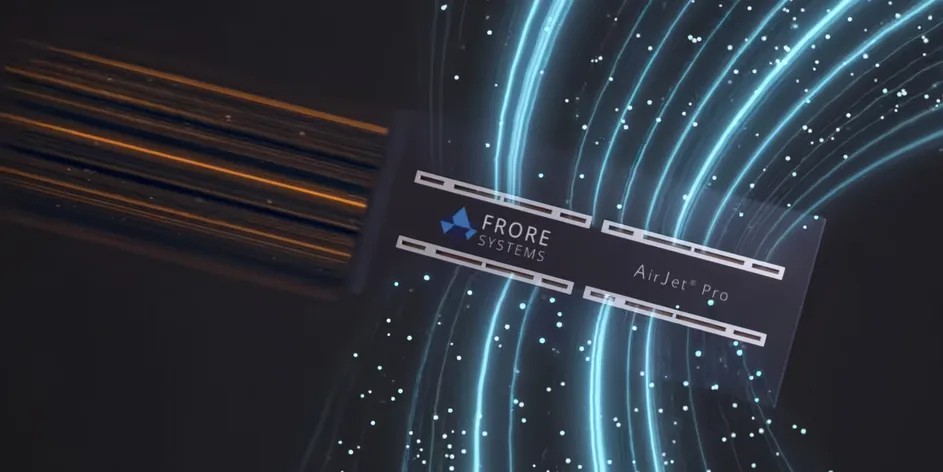Heat as a limiting factor and the need for cooling solutions
The heat is a major obstacle to the development of powerful chips for small devices. Even devices such as the iPhone 14 Pro Max will experience a drop in performance after intense use to avoid damage from excessive heat.
At the moment, cooling fans or passive cooling are the main methods of cooling small devices like smartphones and thin and light laptops. Passive cooling is ineffective for high-power modern chips and cooling fans take up a lot of space.
The Frore AirJet
Frore introduced the AirJet Mini & AirJet Pro as a revolutionary cooling solution. Frore developed a wafer-like device that can propel air up to 200 km/h without the use of fans. This device is made up of a copper-based base that absorbs heat, four intakes with paper filters, an electronic circuit board, which controls the device, and a port for exhausting high-speed air.

Unique Air Movement Mechanism
AirJet’s method of air movement is different from that of conventional pumps or rotary fans. It uses technology from the late 1800s instead to create its airflow.
Frore AirJet: Revolutionizing PC Cooling
People usually think of a rotary airflow fan when they consider air cooling. This approach has a major drawback, however: the motor which drives the fan takes up a lot of space. Even the smallest rotary fan available on the market measures around 9mm by 9mm by 3mm at the time this article was written.
This size is not adequate for some applications, despite its apparent smallness. These miniature fans cannot generate the airflow necessary to cool high-power chip effectively.
Frore’s active cooling chip, in contrast to rotary fans that use traditional components, uses piezoelectric components. The AirJet is called a “solid state thermal solution” because it does not have visible moving parts. This is similar to the difference between a HDD and SSD.
The Curie brothers discovered the phenomenon of Piezoelectricity in 1880. It is the ability of certain materials to generate electricity under mechanical stress. Scientists and engineers reversed this process by creating materials that changed shape in response an electrical current.
They developed a device by alternating the current that moves rapidly back and forth, without the use of a rotary motor, similar to the motion used when using a fan on a hot day.
AirJet mini: impressive airflow and cooling potential
AirJet Mini has a remarkable airflow capability. It measures 41.5mm x 27mm x 2.85mm. It can move 5,95 liters per minute. This is five times as much air as Sunon’s 9mmx9mmx3mm rotary fans, and equal to the airflow of a 12mmx12mmx3mm fan.
Its impressive back pressure of 1.750 Pascal allows it to draw large amounts of air without needing large air intake vents. AirJets that use this technology for cooling are less likely to be contaminated by dust or water.
According to Frore a single AirJet Mini is capable of dissipating 5.25 watts while operating with a noise level as low as 21 dB. It may not be enough for high-performance chips such as the AMD Ryzen 9 7950X3D or the Intel Core i9-13900K, but it allows the installation of processors with a relatively higher power like the 13th Generation Intel Core i3 into compact devices like Intel NUCs.
AirJet is now available on Smartphones and Laptops
When will AirJet be integrated into our devices, given its promising capabilities? It will be some time before manufacturers integrate the technology into their products. The technology was first unveiled in May at Computex.
We have seen a prototype already from a reliable manufacturer. ZOTAC has announced the ZBOX mini PC PI430AJ, an upgrade for their ultra-compact computer line. ZOTAC’s AirJet cooling system allowed them to use a more powerful Intel Core i3 chip in the ZBOX, overcoming their previous limitations of using Intel Celeron processors due to space constraints.
We expect the ZBOX PI430AJ to be available within the year, although the exact release date has yet to confirmed.
AirJet: A New Cooling Technology.
The cooling technology is lagging behind the processor technology. Air cooling has finally begun to catch up with CPU advancements with the AirJet.
AirJet’s introduction promises an even thinner future for smartphones, laptops and tablets without compromising on performance. While we wait for the AirJet to be integrated into our devices, a laptop cooling pad is recommended in the interim. This will improve the performance of your laptop and help prevent it from overheating.

